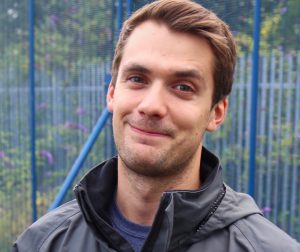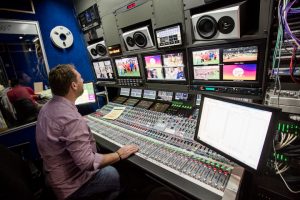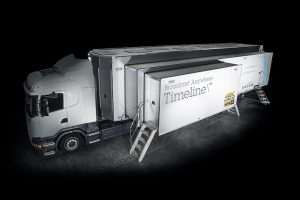SVG Europe Sit-Down: Timeline TV’s Quinn Cowper with insights into remote production and IP innovation

Quinn Cowper, Lead Engineer, Timeline TV
Timeline is a leading authority on shared server systems and specialises in the delivery of IP Director networks. Its diverse activities range from installing systems on outside broadcasts to designing and building permanent installations. For example, the company was responsible for the designing and building of studios for Racing UK at Ealing Studios in west London. In November, Timeline was awarded another two-year contract by Meydan Group to provide the broadcast facilities for all Meydan races in Dubai. The company also operates two large post-production facilities in London and a third in MediaCityUK.
SVG Europe’s conversation with head of vision – outside broadcasts Quinn Cowper began with reflections on 2017…
How would you describe the last 12 months in terms of overall activity levels for Timeline?
Over the last 12 months’ Timeline has grown its OB division with the introduction of our new truck, UHD2 in May 2017. It is an award winning, triple expanding, IP 4K HDR outside broadcast truck and is one of the most advanced in the world. With an Arista 100G switch at its heart and SAM IP infrastructure UHD2 delivers large scale complex OBs simultaneously in uncompressed 4K UHD HDR and 4K UHD SDR. Timeline’s triple-expanding OB truck is designed to support 32 Sony 4K cameras. IP technology removes traditional SDI matrix limits enabling production teams to fully harness the power of UHD 4K. UHD2 is based around the SMPTE 2110 standard enabling both audio and video to be processed in the IP stream.
The build of this new scanner has made the staff at Timeline advance their knowledge and gain a full understanding of possibilities of broadcast over IP. This has enabled Timeline to think differently about how we approach new contracts and how we can be more competitive to stand out from others, as well as offering new services to our existing clients. Broadcasting over IP has advanced so many aspects of the TV industry and we feel that Timeline has a huge leading advantage with the equipment we now own and the training that we have already had to understand this new tech.
What are the challenges for the new year?
The main challenges for us at Timeline will be the continued training required to keep our staff and regular freelancers up to speed with IP technology. We have already made great progress with our training. IP in networks has been around for a long time and has had time to develop, whereas Video over IP – SMPTE-2022-6, 2110 – has only been around for the last few years. As standards like SMPTE-2110 become more understood in the industry we should see a much clearer understanding from broadcast operational users over 2018/19.
How do you assess the future of remote production with regards your business?

The audio desk located in Timeline TV’s UHD2 truck
Remote production is a very interesting discussion topic. Where we now have much better and efficient encoding methods to transmit multiple HD videos from one site to another, we are also being asked to transmit higher quality pictures and sound like 4K/UHD, HDR and double frame rate standards. Ultra-Fast fibre connectivity is starting to appear, but currently there are only a handful of areas that have the infrastructure points to transmit these pictures from remote sites to broadcast centres. These include Premier League grounds, and major city centre hubs where the event is close to infrastructure. A three-week wildlife OB in a nature reserve in Wales will probably not be suitable for a remote production as the connections would not be cost effective. There will always be a need for outside broadcasts in these circumstances.
What do you anticipate will be the next innovation when it comes to IP technology?
When it comes to IP the possibilities are endless. Now that the SMPTE-2110 standard has been ratified, which is Timeline’s preferred standard, over 2018 we will start to see more manufactures producing that all important “2110 Interface”. We know this is going to happen as many manufacturers have already built equipment with SMPTE-2022-6 interfaces. Once this happens we will essentially be able to build this new device into our IP router. This device will become a source and/or destination and be treated the same way that our SAM gateway cards are now used in UHD2. We are also looking to further our IP tech to allow us to interconnect multiple video IP networks together. Difficult to achieve at the moment as there are multiple security concerns that need to be factored when connecting two network switches together especially over long distances. Firewall devices will need to be better implemented into IP systems to combat unauthorized areas within the network switch.
With the on-going integration of IT and broadcast technologies, are the colleges producing engineers with the right knowledge base that will benefit OB providers like Timeline TV?
In May this year, Timeline visited Salford with newly finished UHD2 to talk with industry experts based in the north and to meet with the local Salford University. I was impressed at the final year projects that Laurence Murphy and his 3rd year engineers were creating. I am certain that universities are teaching the most up to date criteria/technology that OB companies are now investing in. Current IP network technology is already complex, but as we advance in technology we will need to keep up with it.
With apologies for the play on words, what do you see as the timeline for the take up of HDR?

UHD2 is an award-winning, triple-expanding, IP 4K HDR outside broadcast truck
Pun excused 😉 HDR is at the top of our vision team’s short terms goals. As UHD2 is fully HDR capable we are training our staff with the latest HDR standards and closely watching the blue-chip broadcasters to see which format the UK is going to choose overall, whether it be HLG, SLOG3 or PQ. We have created a purpose-built area in UHD2 that allows us to monitor and adjust the SDR and HDR pictures at the same time to achieve simultaneous broadcasts. Over the next 6 months we should see a slow uptake on the HDR side, but this is only slow as broadcasters look to transmit simultaneous broadcasts so both SDR and HDR customers can benefit. From Timeline’s point of view, we are ready for our customers to go HDR, whichever standard they choose, and we are already working with some in future projects for 2018. Check back with us next year to find out more…
Doubtless, you have many European case studies you could share – but is there one that really stands out as a success?
Following on from several tests, small outside broadcasts and the successfully delivered IAAF World Championships London Road Races, where we provided live host broadcast coverage of the Marathon and Race Walks for FilmNova. Timeline’s UHD2 truck embarked on a series of UHD broadcasts for BT Sport, aiding its exclusively live coverage of the Scottish Professional Football League Betfred Cup all the way to the final.
The final is covered with 21 camera sources – 16 in true UHD – and some speciality cameras being upconverted from 1080p/50, since they are not available at higher resolution, 7 EVS operators over 5x EVS 8 Channel max machines (we could do UHD, but as ever cost was a deciding factor for the end client) along with Piero and an onsite edit. Sound is provided on site and delivered to BT Sport in Dolby Atmos, to generate an all-immersive audio experience to match the UHD pictures.
All of the above equipment and operational staff comfortably fit in UHD2’s generously sized interior and are easily within its overall technical capability. We look forward to more technically challenging shows for this powerful OB Unit in the future.
